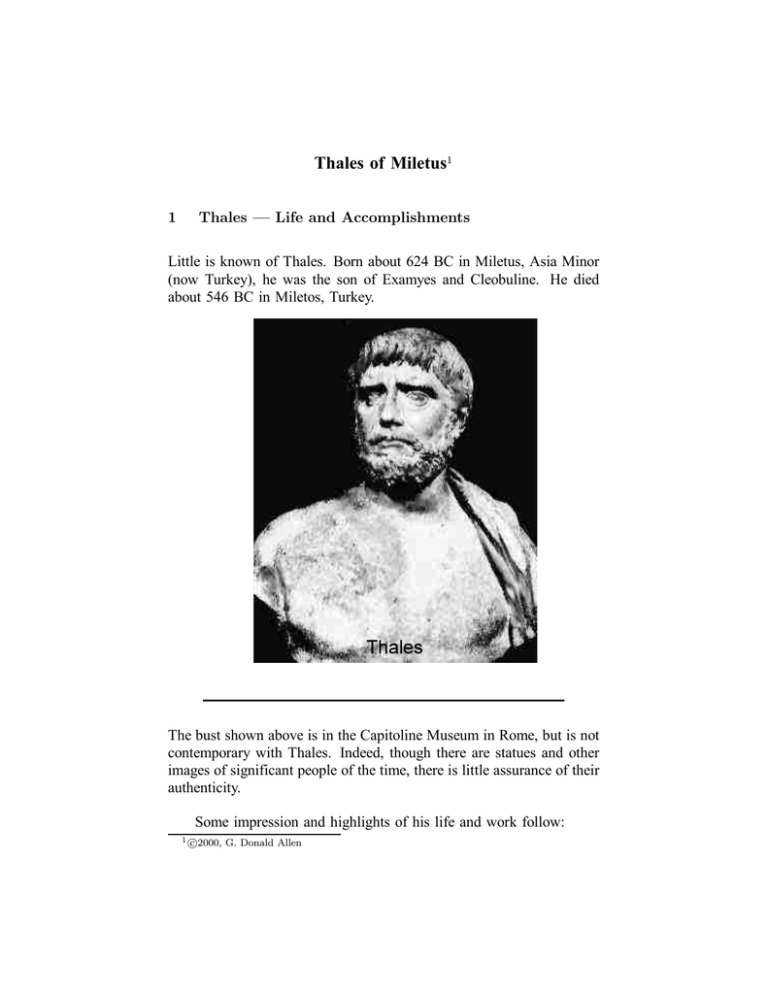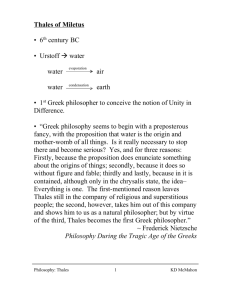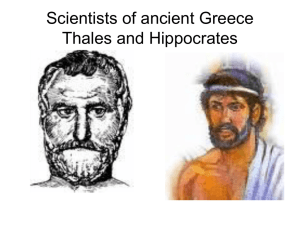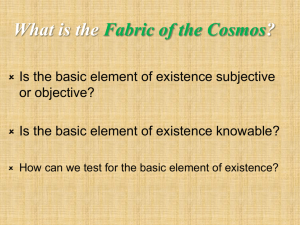Thales of Miletus
advertisement

Thales of Miletus1 1 Thales – Life and Accomplishments Little is known of Thales. Born about 624 BC in Miletus, Asia Minor (now Turkey), he was the son of Examyes and Cleobuline. He died about 546 BC in Miletos, Turkey. The bust shown above is in the Capitoline Museum in Rome, but is not contemporary with Thales. Indeed, though there are statues and other images of significant people of the time, there is little assurance of their authenticity. Some impression and highlights of his life and work follow: 1 °2000, c G. Donald Allen Thales 2 • Thales of Miletus was the first known Greek philosopher, scientist and mathematician. Some consider him the teacher of Pythagoras, though it may be only be that he advised Pythagoras to travel to Egypt and Chaldea. • From Eudemus of Rhodes (fl ca. 320 B.C) we know that he studied in Egypt and brought these teachings to Greece. He is unanimously ascribed to have introduced the mathematical and astronomical sciences into Greece. • He is unanimously regarded as having been unusally clever—by general agreement the first of the Seven Wise Men2 , a pupil of the Egyptians and the Chaldeans. • None of his writing survives and no contemporary sources exist; thus, his achievements are difficult to assess, particularly his philosophy and mathematical discoveries. Indeed, many mathematical discoveries of this early period have been attributed to others, often centuries later. In addition one must consider the ancient practice of crediting particular discoveries to men with a reputation for wisdom. This is no doubt certainly true in Pythagoras’ case. • There is, of course, the story, related by Aristotle, of his successful speculation in olive oil presses after he had concluded there would be a bountiful harvest — as testament to his practical business acumen. • The Greek writer Xenophanes claimed that he predicted an eclipse of the Sun on May 28, 585 BC, startling all of Ionia and thereby stopping the battle between the Lydian Alyattes and the Median Cyaxares. Modern scholars, in further analysis, believe this story is apocryphal, that he could not have had the knowledge to predict an eclipse so accurately. Herodotus spoke of his foretelling the year only. However, the fact that the eclipse was nearly total and occurred during this significant battle possibly contributed to his reputation as an astronomer. It is very likely he used Babyolonian astronomy in his prediction. • He is also said to have used his knowledge of geometry to measure the Egyptian pyramids, though it is equally likely he brought this knowledge back from his studies in Egypt. The reputed method 2 Besides Thales, the other of the Seven Wise Men were Bias of Priene, Chilon of Sparta, Cleobulus of Lindus, Pittacus of Mytilene, Solon of Athens and Periander of Corinth Thales 3 was to use their shadows and therefore proportionality of the sides of similar triangles. • He is credited with five theorems of elementary geometry. This will form the center of our study. • Being asked what was very difficult, he answered, in a famous aphorism, “To Know Thyself.” Asked what was very easy, he answered, “To give advice.” To the question, what/who is God?, he answered, “That which has no beginning or no end.” (The infinite!?!) Asked how men might live most virtuously, he answered, “If we never do ourselves what we blame in others.” According to Diogenes Laertius, Thales died “while present as a spectator at a gymnastic contest, being worn out with heat and thirst and weakness, for he was very old.” From W. K. C. Guthrie3 we have The achievement of Thales, has been represented by historians in two entirely different lights: on the one hand, as a marvelous anticipation of modern scientific thinking, and on the other as nothing but a transparent rationalization of a myth. According to Guthrie himself, one may say that “ideas of Thales and other Milesians created a bridge between the two worlds–the world of myth and the world of the mind.” Thales believed that the Earth is a flat disk that floats on an endless expanse of water and all things come to be from water. This comes to us from Aristotle who suggested that Thales was the first to suggest a single material substratum for the universe. But, more preciesly, Thales and the Milesians proceeded from the assumption of a fundamental unity of all material things that is to be found behind their apparent diversity. This is the first recorded monism, or monistic cosmology, in history. He also regards the world as alive and thus life and matter to be inseparable. Even plants he feels have a immortal “soul”. (This form of pantheism, present in the early stages of Greek philosophy, held that the 3 W. K. C. Guthrie, A History of Greek Philosophy, vol. 1 (Cambridge: Cambridge University Press, 1962), p. 70. Thales 4 divine is one of the elements in the world whose function is to animate the other elements that constitute the world is called hylozoism.) Perhaps the essense of this contribution is that it marks an awakening in mankind the desire to investigate the universe on a non-religious basis, to “model” the universe and to derive conclusions from the model. There would be many models considered, studies, and rejected before our contemporary one. So the new task of philosophers was to establish what exactly provided this unity: one said it was water; another, the Boundless; yet another, air. (The goal is, of course, the quest for rational understanding of the world. Answering “The Big Questions” is the most difficult.)) Thales is believed to have been the teacher of Anaximander; he is the first natural philosopher in the Ionian (Milesian) School. According Anaximander of Miletus (mid-6th century), the word apeiron meant unbounded, infinite, indefinite, or undefined. Originally used to reference the unlimited and that which preceded the separation into contrasting qualities, such as hot and cold, wet and dry, it thus represented the primitive unity of all phenomena. Thus, for the Greeks, the original chaos out of which the world was formed was apeiron. Evidence exists that he wrote treatises on geography, astronomy, and cosmology that survived for several centuries. He is also said to have made a map of the known world. A rationalist, he prized symmetry and introduced geometry and mathematical proportions into his efforts to map the heavens, a tradition that has continued throughout history. We may conclude that his theories departed from earlier, mystical models of the universe and anticipated the achievements of later astronomers. Continuing on a linear path from Thales, Anaximander’s successor, Anaximenes of Miletus (second half of the 6th century), taught that air was the origin of all things. Anaximenes, supplementing the theories of Thales and Anaximander specified the way in which the other things arose out of the water or apeiron. He claimed that the other types of matter arose out of air by condensation and rarefaction. In this way, we see another building block in the development complete model, that of the explanation of phenomena, and this remained essentially the same through all of its transmutations. Thales 2 5 Thales’ Mathematics Thales is also said to have discovered a method of measuring the distance to a ship at sea. There are several theories that conjecture his explanation. The first is to use sightings on short and to construct a congruent triangle on shore and measure the unknown distance. This explanation would have little utility, because the time of measurement of a distant ship would be so long as not to be of use. Ship Shore Using similarity, a bit of geometry known at the time and in particular to Thales if the pyramid story is anywhre near accurate, an alternate explanation uses two shore observation points, where the angles to the ship are measured. This information is given to the observatory where the actual ship-to-shore distance is determined by creating a triangle (∆CDE) similar to triangle ∆ABS. S E Distance A α β B Proportional Distance α β C D Observatory model Shore observation points The actual distance is computed by proportionality. That is Actual distance |AB| = Proportional distance |CD| Thales 6 Five basic propositions with proofs4 of plane geometry are attributed to Thales. Proposition. A circle is bisected by any diameter.5 Proposition. The base angles of an isosceles triangle are equal. Proposition. The angles between two intersecting straight lines are equal. Proposition. Two triangles are congruent if they have two angles and the included side equal. Proposition. An angle in a semicircle is a right angle. On the next page we prove the last of these, referred to as Thales’ Theorem. 4 Exactly why Thales needed to prove theorems and propostions that the Egyptians and Babylonians accepted without justification is even now a subject of conjecture. Many standard philosophical explanations have been given. Clearly, with the new attempts to formulate a scientific model for the world, philosophers might be inclined to establish that existing truths fit within its framework. Truths from geometry may have been the first to fall under such analysis. 5 These propositions, particularly this one comes from Proclus. But we should be careful with what “proof” means here. Even Euclid states this as a fact, i.e. a postulate. Thales 7 Proposition. An angle in a semicircle is a right angle. Proof. From the picture below, note that / DEC is two right angles6 minus / ACE minus / ADE and because the triangles 4ACE and 4AED are isoceles this equals / AEC plus / DEA. Hence / ACE plus / ADE and therefore / DEC is one right angle. In the proof shown in the picture below, the same proof is given using angle notation. E α + β = 180 γ δ γ C β α A 2γ + α = 180 δ D 2δ + β = 180 2(δ + γ) + α + β = 360 δ + γ = 90 Since there was no clear theory of angles at that time, the second version is probably not the proof furnished by Thales. As to the first version, the result indicates that Thales knew that the sum of the angles of a triangle equals two right angles. This was probably known. A simple indicator of why is shown in the illustration to the right. Consider the triangle 4ABC. Construct a line DE parallel to AB C through C. Given knowledge of the E D result about alternating interior angles formed by a transversal cutting two parallels, we have / BCE = / ABC and / BAC = / ACD. Therefore A B the results follows. Another indication proof shown below was furnished by Heath. One first constructs the inscribed triangle, then draws the other diagonal. It is then easy to show that the angles of the resulting quadrilateral are all equal. 6 Note, the modern way to state this is that the sum of the angles of a right triangle is 180o . Thales 8 Proposition. An angle in a semicircle is a right angle. C Alternate approach with the "Thales rectangle", as proposed by Heath. Preknowledge that the sum of the angles of a triangle is two right angles is not needed. B O A D After Thales, the torch of mathematical investication was passed to Pythagoras. Additional References: 1. Apostle, H. G., Aristotle’s Philosphy of Mathematics, University of Chicago Press, Chicago, 1952. 2. Dictionary of Scientific Biography 3. Encyclopaedia Britannica 4. Ueberweg, F., A History of Philosophy, from Thales to the Present Time (1972) (2 Volumes). 5. Guthrie,W. K. C., A History of Greek Philosophy, vol. 1, Cambridge University Press,Cambridge, 1962. 6. Dicks, D. R., lassical Quarterly 9 (1959), 294-309. 7. Heath, Thomas L., A History of Greek Mathematics I, Oxford University Press, Oxford,1921.




